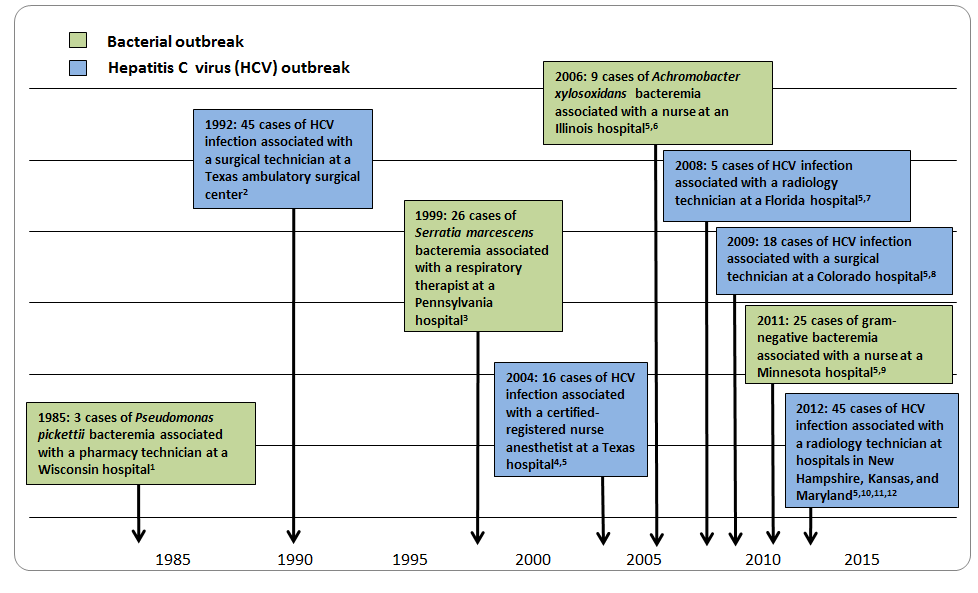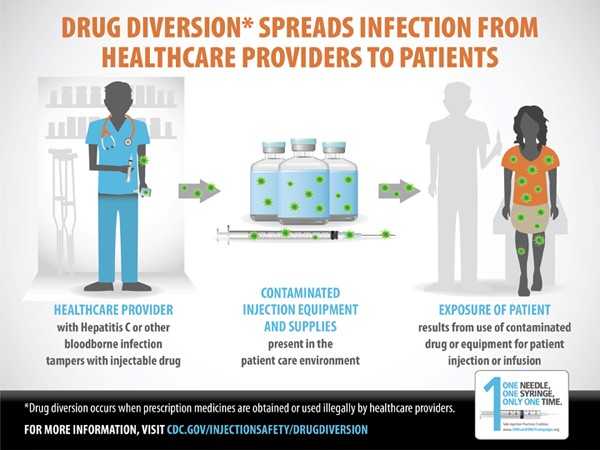Risks of Healthcare-associated Infections from Drug Diversion
When prescription medicines are obtained or used illegally, it is called drug diversion. Addiction to prescription narcotics called opioids has reached epidemic proportions and is a major driver of drug diversion. This webpage focuses on diversion involving healthcare providers who steal controlled substances such as opioids for their own use. This can result in several types of patient harm including:
- Substandard care delivered by an impaired healthcare provider,
- Denial of essential pain medication or therapy, or
- Risks of infection (e.g., with hepatitis C virus or bacterial pathogens) if a provider tampers with injectable drugs.
Outbreaks
CDC and state and local health departments have assisted in the investigation of infection outbreaks stemming from drug diversion activities that involved healthcare providers who tampered with injectable drugs. A summary of recent outbreaks is illustrated in the following timeline.
U.S. Outbreaks Associated with Drug Diversion by Healthcare Providers, 1983-2013

Click here to view larger image
These outbreaks revealed gaps in prevention, detection, or response to drug diversion in U.S. healthcare facilities. Healthcare facilities should have strong narcotics security measures and active monitoring systems to prevent and detect diversion activities. Appropriate response by healthcare facilities includes assessment of harm to patients, consultation with public health officials when tampering with injectable medication is suspected, and prompt reporting to law and other enforcement agencies.
Timeline References

Download the Drug Diversion flyer [PDF – 1.1 MB] from the One and Only Campaign.
Prevention Resources:
- National Association of Drug Diversion Investigators
- Minnesota Hospital Association Drug Diversion Prevention Toolkit
- Drug Diversion in Hospitals: A Guide to Preventing and Investigating Diversion Issues [Word – 137 KB]
- CDC Public Health Ethics Case Study, Unsafe Injections: Duty to Warn? [PDF – 264 KB]
- Premier Inc. Drug Diversion Website
- Substance Abuse and Mental Health Services Administration
- National Institute on Drug Abuse (NIDA)
Enforcement Agencies:
State Health Department Reports:
- Minnesota Controlled Substance Diversion Prevention Coalition [PDF – 391 KB]
- New Hampshire Hepatitis C Outbreak Report [PDF – 3.93 MB]
- Public Health Vulnerability Review: Drug Diversion, Infection Risk [PDF – 1.04 MB]
Videos, Blogs, News, and Podcasts:
- Podcast on Healthcare Provider Diversion/Substitution from NY One & Only Campaign
- Making Lemonade: One CRNA’s Story of Addiction and Recovery – American Association of Nurse Anesthetists Video Lecture
- Drug Diversion in Healthcare Settings – NEW Medscape Video Commentary
- CDC Shares Resources on the Risks of Healthcare-associated Infections from Drug Diversion (AIDS.gov Blog, August 25, 2014)
- Drug Diversion Defined: Steps to Prevent, Detect, and Respond to Drug Diversion in Facilities (CDC’s Safe Healthcare Blog, June 20, 2014)
- Drug Diversion Defined: Consequences for Hospitals and Other Healthcare Facilities (CDC’s Safe Healthcare Blog, June 11, 2014)
- Drug Diversion Defined: A Patient Safety Threat (CDC’s Safe Healthcare Blog, June 3, 2014)
- Outbreaks Highlight Infection Risks Associated with Drug Diversion (CDC’s Safe Healthcare Blog, June 2, 2014)
- Drug Diversion in Health Care Settings Can Put Patients At Risk for Viral Hepatitis (AIDS.gov Blog, May 2, 2014)
- Doctors, medical staff on drugs put patients at risk (USA Today, April 17, 2014)
- Why Aren’t Doctors Drug Tested? (New York Times, March 12, 2014)
- Hospitals Address a Drug Problem (Wall Street Journal, February 23, 2014)
Selected Peer-reviewed Publications:
- Schuppener, L., Pop-Vicas, A., Brooks, E., Duster, M., Crnich, C., Sterkel, A., . . . Safdar, N. (2017).
Serratia marcescens Bacteremia: Nosocomial Cluster Following Narcotic Diversion. Infection Control & Hospital Epidemiology, 1-5. - Warner AE, Schaefer MK, Patel PR, Drobeniuc J, Xia G, Lin Y, Khudyakov Y, Vonderwahl CW, Miller L, Thompson ND. Outbreak of hepatitis C virus infection associated with narcotics diversion by an hepatitis C virus-infected surgical technician. Am J Infect Control. 2015; 43(1): 53–58.
- Schaefer MK, Perz JF. Outbreaks of infections associated with drug diversion by healthcare personnel, United States. Mayo Clinic Proceedings.2014; 89 (6).
- Jones CM, Mack KA, Paulozzi LJ. Pharmaceutical Overdose Deaths, United States, 2010. JAMA. 2013; 309(7):657-659.
- Warner DO et. al., Substance Use Disorder Among Anesthesiology Residents, 1975-2009. JAMA. 2013; 310(21):2289-2296.
- Hellinger WC, Bacalis LP, Kay RS, Thompson ND, Xia GL, Lin Y, Khudyakov YE, Perz JF. Health care–associated hepatitis C virus infections attributed to narcotic diversion. Ann Intern Med. 2012; 156:477-82.
- Berge KH et. al., Diversion of drugs within healthcare facilities, a multiple-victim crime: Patterns of diversion, scope, consequences, detection, and prevention [PDF – 323 KB]. Mayo Clin Proc.2012; 87(7):674-682.
For information on safe injection practices visit CDC’s Injection Safety Websites: Information for Providers , Preventing Unsafe Injection Practices
Timeline References:
- Maki DG, Klein BS, McCormick RD, et al. Nosocomial Pseudmonas pickettii bacteremias traced to narcotic tampering: a case for selective drug screening of health care personnel. JAMA. 1991;265(8):981-986.
- Sehulster L, Taylor J, Hendricks K, VanEgdom M, Whitely S, Manning S. Hepatitis C outbreak linked to narcotic tampering in an ambulatory surgical center [Abstract]. Program and Abstracts of the 37th Annual Interscience Conference on Antimicrobial Agents and Chemotherapy. Washington, DC: American Society for Microbiology. 1997;293.
- Ostrowsky BE, Whitener C, Bredenberg HK, et al. Serratia marcescens bacteremia traced to an infused narcotic. N Engl J Med. 2002;346(20):1529-1537.
- Lee KC, Scoville S, Taylor R, et al. Outbreak of acute hepatitis c virus (HCV) infections of two different genotypes associated with an HCV-infected anesthetist [Abstract]. Poster session at 43rd Annual Infectious Diseases Society of American Annual Conference. San Francisco, CA; October 8, 2005.
- Schaefer MK, Perz JF. Outbreaks of infections associated with drug diversion by healthcare personnel, United States. Mayo Clinic Proceedings. 2014; 89 (6).
- Behrens-Muller B, Conway J, Yoder J, Conover CS. Investigation and control of an outbreak of Achromobacter xylosoxidans bacteremia. Infect Control Hosp Epidemiol. 2012;33(2):180-184.
- Hellinger WC, Bacalis LP, Kay RS, Thompson ND, Xia GL, Lin Y, Khudyakov YE, Perz JF. Health care–associated hepatitis C virus infections attributed to narcotic diversion. Ann Intern Med. 2012; 156:477-82.
- Ramer, H. Hepatitis C tests continue after medical tech David Kwiatkowski’s arrest. HuffingtonPost. December 22, 2012.
- Minnesota Department of Health, Infectious Disease Epidemiology, Prevention and Control Division. Outbreak of gram-negative bacteremia at St. Cloud Hospital. Investigation Summary, Minnesota Department of Health, 2011 [PDF -658 KB]. Sept 14, 2012.
- New Hampshire Department of Health and Human Services, Division of Public Health Services. State of New Hampshire hepatitis C outbreak investigation Exeter Hospital public report [PDF – 3.94 MB]. June 2013.
- Kansas Department of Health and Environment. 2012 News Release. State health officials provide update in the case of potential hepatitis C exposures at Hays Medical Center. August 2012.
- Walker AK. 1,750 had possible contact with technician with hepatitis C. Baltimore Sun. August 12, 2012.
- Page last reviewed: January 4, 2012
- Page last updated: July 12, 2017
- Content source:


 ShareCompartir
ShareCompartir